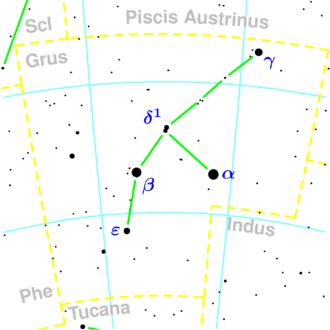NGC 7297
| Galaxy NGC 7297 |
|
|---|---|
|
|
|
| AladinLite | |
| Constellation | crane |
|
Position equinox : J2000.0 , epoch : J2000.0 |
|
| Right ascension | 22 h 31 m 10.3 s |
| declination | -37 ° 49 ′ 35 ″ |
| Appearance | |
| Morphological type | SA (s) bc: / HII |
| Brightness (visual) | 13.7 mag |
| Brightness (B-band) | 14.5 mag |
| Angular expansion | 0.90 × 0.6 |
| Position angle | 130 ° |
| Surface brightness | 12.9 mag / arcmin² |
| Physical data | |
| Redshift | 0.036358 +/- 0.000083 |
| Radial velocity | 10,900 +/- 25 km / s |
|
Stroke distance v rad / H 0 |
(487 ± 34) · 10 6 ly (149.4 ± 10.5) Mpc |
| history | |
| discovery | John Herschel |
| Discovery date | September 1, 1834 |
| Catalog names | |
| NGC 7297 • PGC 69046 • ESO 345-018 • MCG -06-49-007 • IRAS 22282-3804 • 2MASX J22311027-3749352 • SGC 222816-3805.0 • USGC S275 NED06 | |
NGC 7297 is a spiral galaxy with extensive star formation regions of the Hubble type Sbc in the constellation Crane in the southern sky . It is estimated to be 487 million light-years away from the Milky Way and has a diameter of about 130,000 ly
. a. the galaxy NGC 7299 .
The object was discovered by John Herschel on September 1, 1834 .
